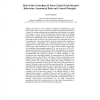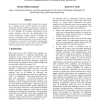79 search results - page 2 / 16 » Control Principles and Role Hierarchies |
NEUROSCIENCE
2001
Springer
13 years 9 months ago
2001
Springer
The Brain is a slow computer yet humans can skillfully play games such as tennis where very fast reactions are required. Of particular interest is the evidence for strategic thinki...
IRI
2005
IEEE
13 years 10 months ago
2005
IEEE
Role-Based Access Control (RBAC) models have emerged as a leading access control approach for today’s information systems. Hybrid role hierarchies introduced in the Generalized ...
SACMAT
2006
ACM
13 years 11 months ago
2006
ACM
Delegation of authority is an important process that needs to be captured by any access control model. In role-based access control models, delegation of authority involves delega...
SACMAT
2003
ACM
13 years 10 months ago
2003
ACM
The Role-Based Access Control (RBAC) model is traditionally used to manually assign users to appropriate roles. When the service-providing enterprise has a massive customer base, ...
SACMAT
2006
ACM
13 years 11 months ago
2006
ACM
Separation of Duty (SoD) is widely recognized to be a fundamental principle in computer security. A Static SoD (SSoD) policy states that in order to have all permissions necessary...


